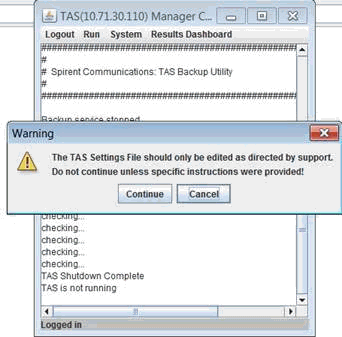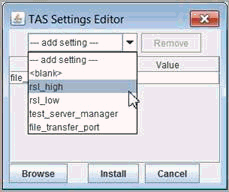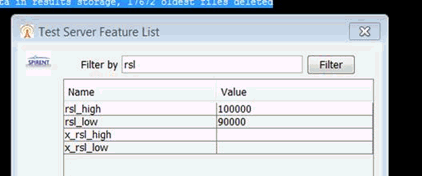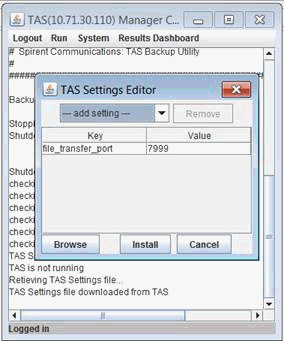Edit Settings
The TAS provides some configurable settings that are read on Startup.
Use the TAS Manager Console to edit TAS settings. Use Edit Settings options to, for example, change the report storage limit.
To edit settings:
|
WARNING: Before you begin making Settings changes, check the System Status to see if there are tests running or other users logged into the system. If there are, use the System Shutdown option to stop the TAS prior to applying your Settings updates. |
-
Start the TAS Manager and login as cfguser.
-
Select System > Edit Settings from the menu, and a warning message displays saying that the TAS settings File should only be edited with specific instructions provided by Technical Support.
-
Click Continue only if you have the appropriate instructions and information to modify the settings.
-
The TAS Settings Editor window displays and provides you with options to Browse your local driver for TAS settings, install new/modified settings, and cancel the task.
-
Click the Add Settings dropdown list, select an item from the list to modify, or select <blank> to add a new setting and double-click to add/modify as per the instructions from Technical Support.
NOTE: Some standard items are listed in the dropdown list, but most items are unlisted and should be manually entered via the <blank> row at the direction of Technical Support
-
Click Install to upload the settings file. A message displays telling you whether the settings file was uploaded and installed successfully.
-
Restart TAS (Run>Restart), log out of and close the TAS Manager Console.
TAS Settings Editor: Before an update, a warning is issued. Talk to support before making any changes!!


Use TAS Settings Editor to update:
- rsl_high- The high water mark (in MB) for Result files that triggers TAS to delete oldest files until reaching the Low Water Mark. aka the Total HD Allocated to Results == How many bytes of the disk partition are expected to be used for Results Storage. Total HD Space == How many bytes the disk partition has.
- rsl_low - The low water mark (in MB) for Result files.
NOTES:
- Default settings provided by current licenses: rsl_low = 9000 , rsl_high = 10000 MB. Can see your current "licensed" value via "View Test Server Feature List".
 These are the Licensed values that would be overridden by the TAS Setting. You will not see the "TAS Settings" values here, just the "Licensed" values.
These are the Licensed values that would be overridden by the TAS Setting. You will not see the "TAS Settings" values here, just the "Licensed" values.- Half Standard, ~5G max storage: rsl_low = 4000 , rsl_high = 5000 MB.
- Cause TAS to use 1/2 Hard Drive Space: rsl_low = -1 , rsl_high = -1.
- The results storage is checked at minimum when every other test session completes. Therefore, you will actually use about one test session’s worth of results above rsl_high, and the next test session you run will trigger the results storage cleanup. If that test session has 1G of results, then you might ultimately use rsl_high+1G, before cleanup is triggered. The TAS will log a message to the Real-Time Logs when file cleanup happens:
-
USER DATE-TIME SEVERITY TYPE ACTION MESSAGE
-
<system> 2017-04-12 17:58:53 Informational SysAdmin Run Over quota in results storage, 17672 oldest files deleted
-
Example: If rsl_high is set to = 100 and rsl_low to 10GiB that would mean 90% and 90 GiB of the space is cleaned up at a time, this will waste a lot of time in a single time and remove a lot of the file history. The idea would be to keep as much history as possible, keep rsl_low high, and do a cleanup that’s a balance of being quick enough and large enough. We recommend that rsl_low is 75-80% of rsl_high. Additional details in Results Storage and About the System Status Window.
-
rslHighMiB and rslLowMiB details added to the RESTful API, status query json :
"numRunningTestServers": 0,
"remainingDisk": 25201,
"remainingMemory": 2320,
"resultsSizeMiB": 8238,
"rslHighMiB": 10000,
"rslLowMiB": 9000,
"tasVersion": "99.9.0.2020-03-12.4drd",
"testServers": [
NOTE: Added support via Swagger (RESTFul API - Using the RESTful API) to manually GET / DELETE / from Results Storage, independent of the Automatic Cleanup. By doing so, you can better control which files remain over a longer period of time. i.e. if you remove all the large PCAPs every hour, more room is left within the rsl_high limit for other types of files.
- test_server_manager - Controls whether you have Test Server Reservation Scheduler feature or Test Server Assignment feature. Value of "ON" turns on Test Server Reservation manager, any other value turns on Test Server Assignment feature. If the setting is not defined, the TAS will work on the License (as it does today).
- ts_assignment_level - Allows for lowering the privilege of TS Assignment back from System Admin or above to it's previous value. 1 = System Admin (new default) or 2 = Test Admin (previous default privilege level prior to release 17.2)
- file_transfer_port - This setting is no longer supported. It will be ignored if used. File transfers to / from the Client / TAS are now done over the TAS Service TCP/TLS-based ports.
- auto_checkin_timeout_mins - Range : 30 to 4320 (3 days) in minutes. The TAS will go to Locked state after being disconnected from License Server for the range set here.
- case_sensitive_usernames Value ON/OFF - Value ON to support case sensitive usernames. Otherwise the TAS will handle username case insensitively for authentication and administration. When set to ON, TAS will operate in case-sensitive mode for usernames WRT to authentication and user admin. And the TAS startup log will include: "Case Sensitive Usernames Enabled". Additional details in About User Accounts.
- client_read_timeout_s - int (1-72) : Sets the number of seconds the TAS will wait to read initial message from a client. Default is 10s. If the first message sent to the TAS by a client connection takes longer than “client_read_timeout_s” to starting reading by the TAS, that connection will be closed.
- max_client_inactivity_hours -If the client has not sent a request in “max_client_inactivity_hours”, the client will be forcibly disconnected with a message “due to inactivity (no user requests)”. Default : 36 hours
- dhcp_test_servers - Set to ON for Test Server Discovery mode - where test server IP addresses are not entered by the user, instead users should enter the TS's hostname as its name. When the TS registers with the TAS it includes its own hostname and the TAS then assigns the IP Address. Additional details about Discovery Mode in Adding a Test Server.
- force-tac-report - Set to ON for all test sessions to automatically produce an "end of test" TAC Report regardless of the setting in Test Session. The run log will indicate "Forced TAC Report Generation is Enabled".
- force_reliable_ctrl_msgs - Set to ON for all tests to use reliable control messaging (aka Remote TS Control Messaging). NOTE: Reliable Messaging / Remote-TS-Control-Messaging will not be turned on in the Test Session configuration if you enable this TAS-Setting. But regardless of what is set in the Test Session configuration, when this setting is ON, it will use reliable messaging. About the Test Session Window
- ts_admin_alternate_permissions - When this option is set to “ON” the Recycle and Stop All Sessions on TS buttons are enabled for Test Operator level users.
- lic_srv_proxy_host - Select to add Proxy support between the TAS and the License Server. Enter the IP address of the Proxy Server.
- lic_srv_proxy_port - Select to add Proxy support between the TAS and the License Server. Enter the Port of the Proxy Server.
- lic_srv_primary_switchback_mins - Sets the timeout for secondary License Server to switch back to primary. Range : (15 to 4320 minutes)
- lic_srv_redundant_flip - ON/OFF: Value ON will use the secondary License Server configured in license as the primary.
- snmp_file_logging - Select to turn on logging of the SNMP Traps communications on the TAS. See Customizing your Environment - Server Setting - SNMP.
- kafka_file_logging - Select to turn on logging of the Kafka communications on the TAS to help debug problems. See Customizing your Environment - Server Setting - Kafka.
- snmp_hd_trap_check_period_mins - Sets the number of minutes between checks of hard drive usage for sending SNMP traps. Range : 1 to 10 minutes, default : 5. About the System Status Window
- scheduler_file_logging - Select to turn on logging of the Test Scheduler. This enables the /usr/sms/data/TestScheduler.log file(s) with some inner details of the Test Scheduler logic. These will end up in TAS Debug Logs.
- tas_fqdn - Sets the HOST that the TAS will use for all URLs it builds in APIs and external notifications (Kafka/SNMP), in lieu of IP-Address. When the TAS is started, the startup log will print information about IP Address and Hostname: TAS FQDN set to: test.tas.spirent.com
- optimized_results_transfers - On/OFF - Value ON to force all tests to use optimized files transfers (tcN_test_result.tar.gz/extracted/deleted. Value OFF to force disable it. Reporting Options ( Optimized File Transfers ) provides 3 options that can be set at the session level - TS Compress Results, TAS Extract Files and Do Not Delete Tarball . If optimized_results_transfers is set to ON and the Test Session has "TS Compress Results" turned off in Reporting Options, the Test will be converted to the default optimized transfer mode: TS Compress Results Enabled, TAS Extract Files Enabled and Do Not Delete Tarball Disabled. A Run Log Message will be logged if Test mode was changed due to this. If set OFF and the Test Session has "TS Compress Results" turned on, the Test will be converted to disable optimized transfer mode and a Run Log Message will be logged. When TAS is started and the TAS Setting is set properly, a tasoutput.txt message "Optimized Results Transfers forced: ON" (or OFF respectfully).
- reliable_log_file_size - Select to control the size of the ReliableMsgs.log file. By default it will log up to 1.5MB of messages. This file is where the ACK-ing of messages received from the TS for our UDP Reliable Messaging feature are logged.
- teamviewer_for_all - Setting "teamviewer_for_all=ON" turns on TeamViewer for ALL Users.
- tp_threshold - TS temperature Threshold value (integer value) for all TSs. Additional details in Managing Your Test Servers.
- case_sensitive_usernames is not set “ON”, the TAS will operate in case-insensitive mode for usernames WRT to authentication and user admin. When the ‘case_sensitive_usernames’ option is set to ON, TAS will operate in case-sensitive mode for usernames WRT to authentication and user admin.
When set to ON, the TAS startup log will include: "Case Sensitive Usernames Enabled". Additional details in About User Accounts. - gui_import_timeout_s - Range : 1 to 65535 seconds. The GUI Test Suite Importer has a built-in Timeout period to prevent users from leaving the window open and blocking API users. Once the Import process has started (viewing/reviewing STE contents), the GUI will require a user to Execute the IMPORT within X Seconds or else it will be automatically unlocked. The GUI Auto-Unlock will default to 5 minute (300s) timeout, this value can be controlled by the TAS-Setting gui_import_timeout_s to 1 to 65535 seconds. Set gui_import_timeout_s to 0 to disable the feature.
- import_lock_timeout_s - Range : 1 to 65535 seconds. The Default/Configured Wait Timer for RESTful API imports on the TAS is 5 seconds by default, the TAS-Setting import_lock_timeout_s can be used to update this to another value.
- running_0_recycle - Setting "running_0_recycle=ON" automatically recycles TSs that report RUNNING[0] Status for more than 10s. To ensure TSs are not recycled unnecessary, there is a delay period of 10 seconds to give the TS some time to cleanup the test (s) that might be running. Additional details in topic About Test Server Status.
- max_tas_memory_mb - Select to manually set the TAS Memory. We have changed our TAS JRE Memory allocations, adding more memory levels and increased memory for most levels. Use this setting for troubleshooting or in special cases (when running larger tests) to manually set the Memory. We recommend that the TAS JRE never take up more than 85% of the memory and leave the remainder for Apache, MySQL, SSH, and other OS services to use. The standard C100 type TAS should now get 63GB allocated for JRE. But the vTASs might be anywhere in this range.
-
System Memory Approximate TAS Max JRE Memory 2GB to 3.5GB 1.65GB 3.5GB to 7GB 2.5GB 7GB to 10GB 4.5GB 10GB to 15GB 8GB 15GB to 23GB 12GB 23GB to 31GB 18GB 31GB to 50GB 22GB 50GB to 80 GB 45GB 80GB+ 62GB
|
IMPORTANT: If the settings above are NOT in the TAS Settings, it will default to whatever is in the license or half the hard drive in the case of Result Files (if there is nothing in the license). These TAS Settings provide the user with an override capability without requiring a new license. The TAS Settings supercede the license setting for the settings listed above. |

Via CLI, tas-help commands: (remember to restart the TAS after changing the settings):
| Command | Description/Purpose |
| list-tas-settings | List the TAS configuration settings |
| set-tas-setting | Set or update a TAS configuration setting Usage: set-tas-setting < setting_name > < setting_value > |
| remove-tas-setting | remove a TAS configuration setting Usage: remove-tas-setting < setting_name > |